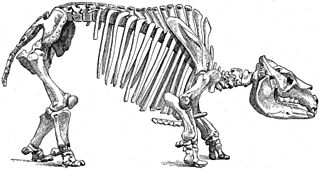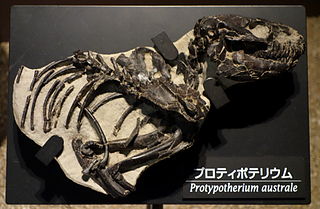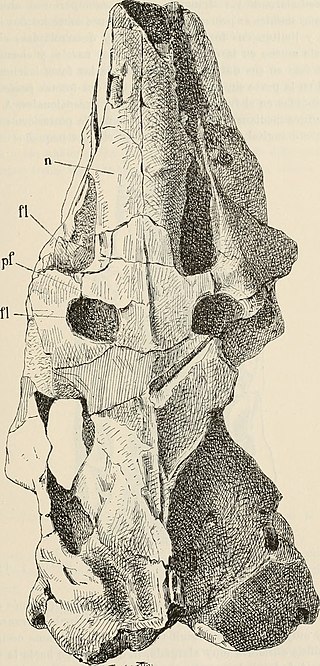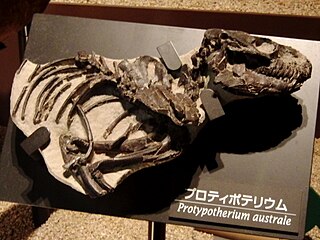
Notoungulata is an extinct order of mammalian ungulates that inhabited South America from the early Paleocene to the Holocene, living from approximately 61 million to 11,000 years ago. Notoungulates were morphologically diverse, with forms resembling animals as disparate as rabbits and rhinoceroses. Notoungulata are the largest group of South American native ungulates, with over 150 genera in 14 families having been described, divided into two major subgroupings, Typotheria and Toxodontia. Notoungulates first diversified during the Eocene. Their diversity declined from the late Neogene onwards, with only the large toxodontids persisting until the end of the Pleistocene, perishing as part of the Quaternary extinction event among with most other large mammals in the Americas. Collagen analysis suggests that notoungulates are closely related to litopterns, another group of South American ungulates, and their closest living relatives being perissodactyls, including rhinoceroses, tapirs and equines as part of the clade Panperissodactyla. However their relationships to other South American ungulates are uncertain. Several groups of notoungulates separately evolved ever-growing cheek teeth.

Protypotherium is an extinct genus of notoungulate mammals native to South America during the Oligocene and Miocene epochs. A number of closely related animals date back further, to the Eocene. Fossils of Protypotherium have been found in the Deseadan Fray Bentos Formation of Uruguay, Muyu Huasi and Nazareno Formations of Bolivia, Cura-Mallín and Río Frías Formations of Chile, and Santa Cruz, Salicas, Ituzaingó, Aisol, Cerro Azul, Cerro Bandera, Cerro Boleadoras, Chichinales, Sarmiento and Collón Curá Formations of Argentina.

Interatheriidae is an extinct family of notoungulate mammals from South America. Interatheriids are known from the Middle Eocene (Mustersan) to the Early Pleistocene (Uquian). These animals were principally small-sized, occupying a habitat like hares, marmots and viscachas. The majority were very small, like rodents.

Interatherium is an extinct genus of interatheriid notoungulate from the Early to Middle Miocene (Colhuehuapian-Mayoan). Fossils have been found in the Santa Cruz, Collón Curá and Sarmiento Formations in Argentina.

Miocochilius is an extinct genus of small notoungulate mammals (typotheres) native to South America. The genus lived during the Middle Miocene epoch. The genus contains two described species, the type species M. anomopodus described in 1953 by Ruben Arthur Stirton and M. federicoi, described and included in the genus by Darin A. Croft.
Cullinia is an extinct genus of litoptern, an order of South American native ungulates that included horse-like and camel-like animals such as Macrauchenia. It is only known from fragmentary remains. Cullinia levis is known from Chasicoan remains found in the Arroyo Chasicó Formation of Argentina, and remains from the Brazilian state of Acre and the Huayquerian Ituzaingó Formation have been assigned to Cullinia sp..

Hemihegetotherium is an extinct genus of hegetotheriid notoungulate that lived from the Middle to the Late Miocene of what is now Argentina.
Antofagastia is an extinct genus of Notoungulate, belonging to the family Interatheriidae. It lived during the Late Eocene in what is today South America.
Anayatherium is an extinct genus of notoungulate belonging to the family Leontiniidae. It lived during the Late Oligocene, and its fossilized remains were discovered in South America.

Plesiotypotherium is an extinct genus of Notoungulate, belonging to the suborder Typotheria. It lived from the Middle to the Late Miocene, and its fossilized remains were discovered in South America.

Interatheriinae is an extinct subfamily of interatheriids that consisted of notoungulates dating from the Early Eocene to the Early Pliocene. The subfamily includes the genera Archaeophylus, Argyrohyrax, Boleatherium, Brucemacfaddenia, Caenophilus, Choichephilum, Cochilius, Eopachyrucos, Federicoanaya, Interatherium, Juchuysillu, Miocochilius, Neoicochilus, Patriarchus, Proargyrohyrax, Progaleopithecus, Protypotherium, and Santiagorothia. They were small to medium sized interatheres, and when compared to the other subfamily, Notopithecinae, interatheriines are found to occupy an advanced, derived position in the family.
Argyrohyrax is an extinct genus of interatheriid notoungulate that lived during the Late Oligocene, of what is now Argentina and Bolivia.
Patriarchus is an extinct genus of interatheriid notoungulates that lived during the Early Miocene in what is now Argentina. Fossils of this genus have been found in the Santa Cruz Formation of Argentina.
Santiagorothia is an extinct genus of interatheriid notoungulate. It lived during the Early Oligocene, and its fossils were discovered in Argentina and Chile.

Cochilius is an extinct genus of interatheriid notoungulate that lived between the Late Oligocene and the lower Miocene in what is now Argentina.

Notopithecus is an extinct genus of Notoungulate, belonging to the suborder Typotheria. It lived from the Middle to the Late Eocene and its fossilized remains were discovered in South America.
Chasicobradys is an extinct genus of ground sloths of the family Nothrotheriidae that lived in what is now Argentina. Chasicobradys was discovered in the Arroyo Chasicó Formation, in Buenos Aires Province. It is only known from jaw fragments and teeth, which allowed the identification of this species, and was classified as a member of the nothrotheriid subfamily Nothrotheriinae, which comprises small to medium-sized species of ground sloths.
Boleatherium is an extinct genus of interatheriid notoungulate that lived from the Early to Middle Miocene of what is now Argentina. Fossils of this genus have been found in the Cerro Boleadoras Formation, the formation which this genus was named after.
Federicoanaya is an extinct genus of interatheriine notoungulates that lived during the Late Oligocene in what is now Bolivia. Fossils of this genus have been found in the Salla Formation of Bolivia.
Brucemacfaddenia is an extinct genus of interatheriine notoungulates that lived during the Late Oligocene in what is now Bolivia. Fossils of this genus have been found in the Salla Formation of Bolivia.

















